高一上学期英语教案:Unit 9 Wheels
- 格式:doc
- 大小:34.51 KB
- 文档页数:16
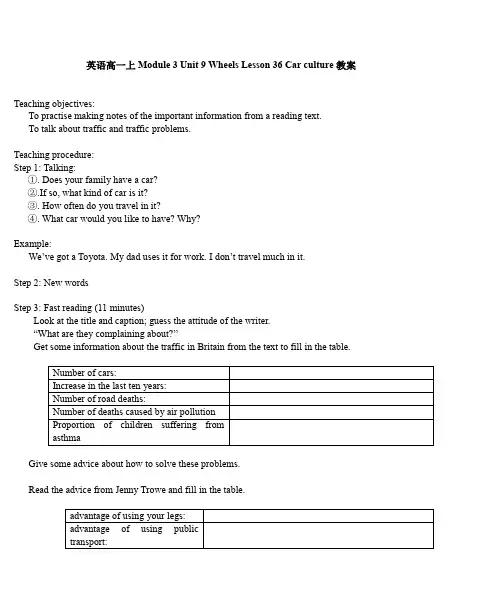
英语高一上Module 3 Unit 9 Wheels Lesson 36 Car culture教案Teaching objectives:To practise making notes of the important information from a reading text.To talk about traffic and traffic problems.Teaching procedure:Step 1: Talking:①. Does your family have a car?②.If so, what kind of car is it?③. How often do you travel in it?④. What car would you like to have? Why?Example:We’ve got a Toyota. My dad uses it for work. I don’t travel much in it.Step 2: New wordsStep 3: Fast reading (11 minutes)Look at the title and caption; guess the attitude of the writer.“What are they complaining about?”Get some information about the traffic in Britain from the text to fill in the table.Give some advice about how to solve these problems.Read the advice from Jenny Trowe and fill in the table.Step 4: Detailed Reading①Listen to the text and answer the following questions.1.What are then A10, the M11 and the M25?2.Why do people make excuses?3.Dose Jenny Trowe think the adverts on TV are true?4.According to Jenny Trowe, what are the ways of making streets safer?5.Did the writer decide to give up his car, after getting these suggestions?②Which sentence below best summarises the writer’s attitude to cars?1.He thinks they have more disadvantages than advantages.2.He knows what he should do, but uses his car because it is convenient.3.He thinks it would be easy for us all to use our cars less.Step 5: Consolidation – fill in a cloze with proper words from the text.The traffic situation in Britain is not good. Many people often get ___________ in traffic jams on their way to school or work. More and more cars go on the road every year. The number of cars has _________ _______ by 30% in the last ten years. And there are more road deaths as well. Because of the air pollution, one ______ seven children in Britain __________ __________ asthma; some types of _________ are related to traffic pollution too. Traffic can cause global warming and ___________ change too.Since so many people are ___________ to cars, Jenny Trowe gives six pieces of _________ about how to _________ ________ cars: 1. Use your legs for _________ journeys. 2. Use public transport so that there will be ________ cars on the road. 3. Think before you go, “Do you really need to make that journey?” 4. Share cars ________ others. 5. Don’t believe the adverts. Most of them are not _________.6. Take action. Don’t just sit around and _________. The advice sounds ___________, however, it is difficult for those who have a deep addiction to cars.Step 6: Extension—Discuss the traffic in Nanhai.In groups of four, discuss the traffic in your towns or in Nanhai.Step 7: Homework。
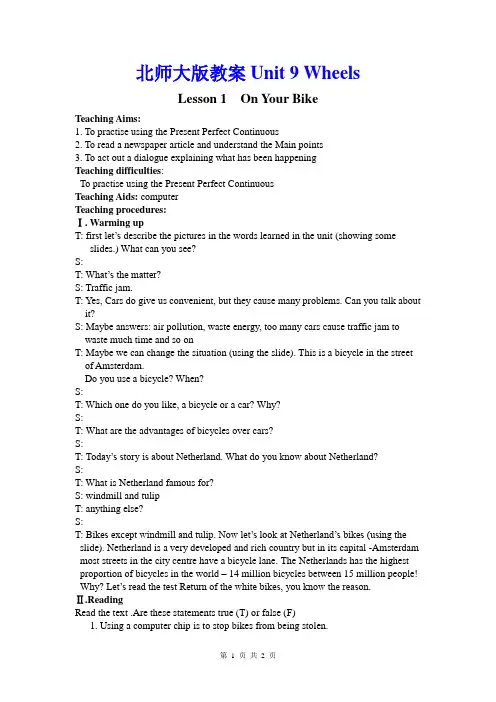
北师大版教案Unit 9 WheelsLesson 1 On Your BikeTeaching Aims:1. To practise using the Present Perfect Continuous2. To read a newspaper article and understand the Main points3. To act out a dialogue explaining what has been happeningTeaching difficulties:To practise using the Present Perfect ContinuousTeaching Aids: computerTeaching procedures:Ⅰ. Warming upT: first let‘s describe the pictures in the words learned in the unit (showing some slides.) What can you see?S:T: What‘s the matter?S: Traffic jam.T: Yes, Cars do give us convenient, but they cause many problems. Can you talk about it?S: Maybe answers: air pollution, waste energy, too many cars cause traffic jam to waste much time and so onT: Maybe we can change the situation (using the slide). This is a bicycle in the street of Amsterdam.Do you use a bicycle? When?S:T: Which one do you like, a bicycle or a car? Why?S:T: What are the advantages of bicycles over cars?S:T: Today‘s story is about Netherland. What do you know about Nethe rland?S:T: What is Netherland famous for?S: windmill and tulipT: anything else?S:T: Bikes except windmill and tulip. Now let‘s look at Netherland‘s bikes (using the slide). Netherland is a very developed and rich country but in its capital -Amsterdam most streets in the city centre have a bicycle lane. The Netherlands has the highest proportion of bicycles in the world – 14 million bicycles between 15 million people! Why? Let‘s read the test Return of the white bikes, you know the reason.Ⅱ.ReadingRead the text .Are these statements true (T) or false (F)1. Using a computer chip is to stop bikes from being stolen.2. Now in Amsterdam all the bicycles are painted white.3. In Amsterdam riding a bicycle is very convenient. You can find a bicycleanywhere.4. Over 40 years people have been enjoying the benefits of cycling in Amsterdam.5. In Amsterdam no car is allowed in the city centre and only bicycles are.6. In order to reduce pollution and save energy, cycling fans had another ideaof using a computer card 30 years later.7. Almost every one buys bicycle in Amsterdam.Answers: T F F F F F FⅢ. Listening and SpeakingTask 1 Listen to the tape and read the text aloudTask 2 Answer the questions1. Why Amsterdam is called the ―City of Bicycles‖?2. Why did the first ―white bikes‖ plan fail?3. What effects have the white bikes had?4. Do you think the ‗white bikes‘ would be good for your town or city? Saywhy.Draw a conclusion: With the development of the society more and more carscome into our life. Cars do bring us convenient at the same time and causemany questions, so we should care for our environment and learn fromNetherlandTask 3 do the exercise 4Ⅳ Language points1. paint… (color) 染上某种颜色。
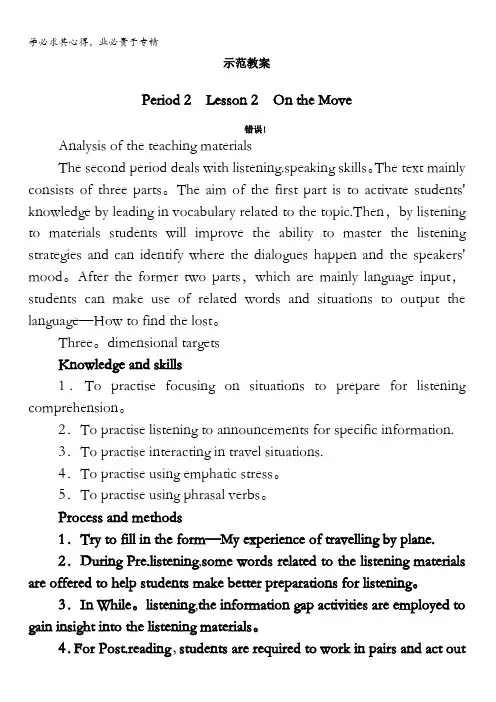
示范教案Period 2 Lesson 2 On the Move错误!Analysis of the teaching materialsThe second period deals with listening.speaking skills。
The text mainly consists of three parts。
The aim of the first part is to activate students' knowledge by leading in vocabulary related to the topic.Then,by listening to materials students will improve the ability to master the listening strategies and can identify where the dialogues happen and the speakers' mood。
After the former two parts,which are mainly language input,students can make use of related words and situations to output the language—How to find the lost。
Three。
dimensional targetsKnowledge and skills1.To practise focusing on situations to prepare for listening comprehension。
2.To practise listening to announcements for specific information.3.To practise interacting in travel situations.4.To practise using emphatic stress。
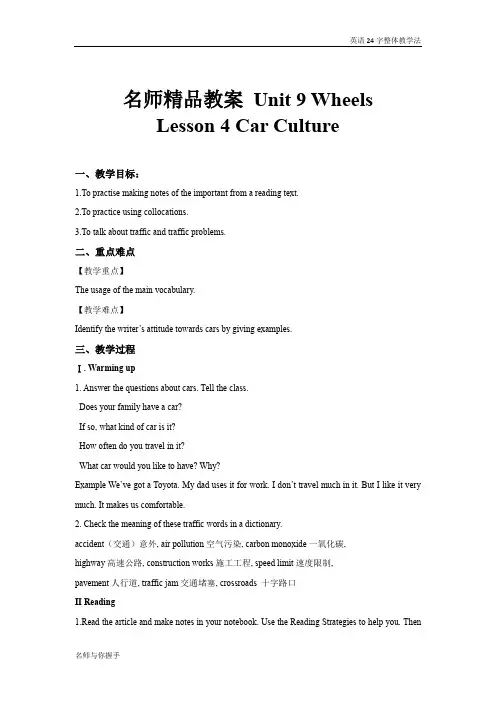
名师精品教案Unit 9 WheelsLesson 4 Car Culture一、教学目标:1.To practise making notes of the important from a reading text.2.To practice using collocations.3.To talk about traffic and traffic problems.二、重点难点【教学重点】The usage of the main vocabulary.【教学难点】Identify the writer’s attitude towards cars by giving examples.三、教学过程Ⅰ. Warming up1. Answer the questions about cars. Tell the class.Does your family have a car?If so, what kind of car is it?How often do you travel in it?What car would you like to have? Why?Example We’ve got a Toyota. My dad uses it for work. I don’t travel much in it. But I like it very much. It makes us comfortable.2. Check the meaning of these traffic words in a dictionary.accident(交通)意外, air pollution空气污染, carbon monoxide一氧化碳,highway高速公路, construction works施工工程, speed limit速度限制,pavement人行道, traffic jam交通堵塞, crossroads 十字路口II Reading1.Read the article and make notes in your notebook. Use the Reading Strategies to help you. Thencomplete it.Traffic in BritainNumber of cars: 25millionIncrease in the last ten years: 30%Amount of TV advertising: 1/4Proportion of short car journeys: 25% under 2 milesChemicals produced by cars: carbon monoxideHealth effects of air pollution: 25,000 deaths p.a., types of cancer caused by traffic pollutionNumber of road deaths: over 3,000 per yearAdvantages of buses over cars: 40 people travel in 1 bus, you can relax on a bus Advantages of sharing a car: cheaper and kinder to environmentAdvantages of physical exercise: saves money, keeps you fit and helps you live longer, cuts the risk of heart diseaseWays of making streets safer: speed limit, pedestrian area2.Post-readingRead the text again and answer these questions:1).What are the A10, the M11 and the M25?Roads.2).What effect does traffic have on people?Makes them angry and stressed.3). Why do people make excuses?Because they want to continue using their cars.4). What does Jenny Trowe think about car adverts on TV?They present an untrue picture of driving and cars.5). How does she think we should change our lifestyles?We should take action by writing to the papers, going to the town council, getting a protest group together.III HomeworkWrite an article about the advantages and disadvantages of having a car according to the text.。
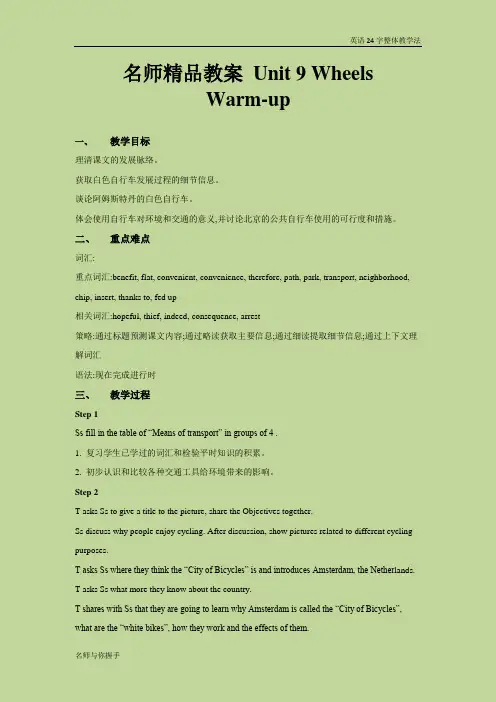
名师精品教案Unit 9 WheelsWarm-up一、教学目标理清课文的发展脉络。
获取白色自行车发展过程的细节信息。
谈论阿姆斯特丹的白色自行车。
体会使用自行车对环境和交通的意义,并讨论北京的公共自行车使用的可行度和措施。
二、重点难点词汇:重点词汇:benefit, flat, convenient, convenience, therefore, path, park, transport, neighborhood, chip, insert, thanks to, fed up相关词汇:hopeful, thief, indeed, consequence, arrest策略:通过标题预测课文内容;通过略读获取主要信息;通过细读提取细节信息;通过上下文理解词汇语法:现在完成进行时三、教学过程Step 1Ss fill in the table of “Means of transport” in groups of 4 .1. 复习学生已学过的词汇和检验平时知识的积累。
2. 初步认识和比较各种交通工具给环境带来的影响。
Step 2T asks Ss to give a title to the picture, share the Objectives together.Ss discuss why people enjoy cycling. After discussion, show pictures related to different cycling purposes.T asks Ss where they think the “City of Bicycles” is and introduces Amsterdam, the Nether lands. T asks Ss what more they know about the country.T shares with Ss that they are going to learn why Amsterdam is called the “City of Bicycles”, what are the “white bikes”, how they work and the effects of them.1. 用图片导出话题、与学生交流学习目标。
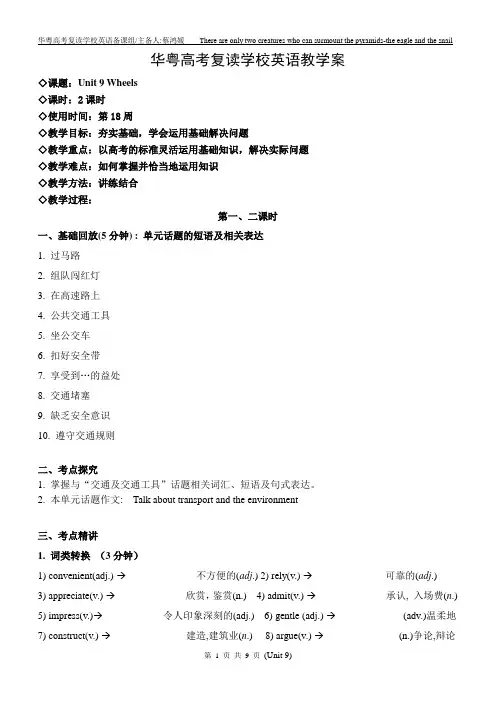
华粤高考复读学校英语教学案◇课题:Unit 9 Wheels◇课时:2课时◇使用时间:第18周◇教学目标:夯实基础,学会运用基础解决问题◇教学重点:以高考的标准灵活运用基础知识,解决实际问题◇教学难点:如何掌握并恰当地运用知识◇教学方法:讲练结合◇教学过程:第一、二课时一、基础回放(5分钟) : 单元话题的短语及相关表达1. 过马路_________________________________________2. 组队闯红灯_________________________________________3. 在高速路上_________________________________________4. 公共交通工具_________________________________________5. 坐公交车_________________________________________6. 扣好安全带_________________________________________7. 享受到…的益处_________________________________________8. 交通堵塞_________________________________________9. 缺乏安全意识_________________________________________10. 遵守交通规则_________________________________________二、考点探究1. 掌握与“交通及交通工具”话题相关词汇、短语及句式表达。
2. 本单元话题作文: Talk about transport and the environment三、考点精讲1. 词类转换(3分钟)1) convenient(adj.) →______________不方便的(adj.) 2) rely(v.) → ______________可靠的(adj.)3) appreciate(v.) →______________欣赏,鉴赏(n.) 4) admit(v.) →______________承认, 入场费(n.)5) impress(v.)→____________令人印象深刻的(adj.) 6) gentle (adj.) →_____________ (adv.)温柔地7) construct(v.) →_______________建造,建筑业(n.) 8) argue(v.) →_______________(n.)争论,辩论2. 固定搭配(5分钟)1) be _______________ as/ to be被认为是2) be _____________ in 在…丰富3) _____ average 平均起来4) be fed up ________ 对…感到厌倦5) benefit _________ 从…中受益6) argue with sb. ________ sth.因…和某人争吵7) be _____________ with 对…满意的8) pull ______ 停车9) ______________ with/ to 与…相比10) check _____ 登记,报到11) be ______________ to 沉溺于…12) be _____________ for 适合13) go的短语:________________ 上升,上涨_______________ 追逐,追求________________ 爆炸,离开,响起________________ 继续________________ 仔细检查________________ 经历,穿过3. 英译中(2分钟)1) pedestrian_____________ 2) insert _______________ 3) consequence __________ 4) arrest ________________ 5) crossroad ____________ 6) fierce ______________ 7) accent _______________ 8) schedule _____________ 9) suitcase _____________4. 单句语法在下面的句子的空格处填入一个适当的词或者用所给的词的正确形式填空。
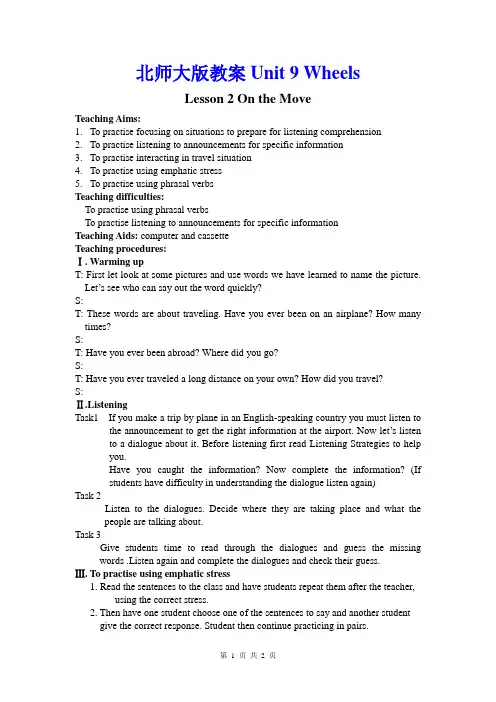
北师大版教案Unit 9 WheelsLesson 2 On the MoveTeaching Aims:1.To practise focusing on situations to prepare for listening comprehension2.To practise listening to announcements for specific information3.To practise interacting in travel situation4.To practise using emphatic stress5.To practise using phrasal verbsTeaching difficulties:To practise using phrasal verbsTo practise listening to announcements for specific informationTeaching Aids: computer and cassetteTeaching procedures:Ⅰ. Warming upT: First let look at some pictures and use words we have learned to name the picture. Let’s see who can say out the word quickly?S:T: These words are about traveling. Have you ever been on an airplane? How many times?S:T:Have you ever been abroad? Where did you go?S:T: Have you ever traveled a long distance on your own? How did you travel?S:Ⅱ.ListeningTask1 If you make a trip by plane in an English-speaking country you must listen to the announcement to get the right information at the airport. Now let’s listen to a dialogue about it. Before listening first read Listening Strategies to help you.Have you caught the information? Now complete the information? (If students have difficulty in understanding the dialogue listen again)Task 2Listen to the dialogues. Decide where they are taking place and what the people are talking about.Task 3Give students time to read through the dialogues and guess the missing words .Listen again and complete the dialogues and check their guess.Ⅲ. To practise using emphatic stress1. Read the sentences to the class and have students repeat them after the teacher,using the correct stress.2. Then have one student choose one of the sentences to say and another studentgive the correct response. Student then continue practicing in pairs.3. Give students time to read through the sentences and alternative responsesbefore playing the cassette.4. Students then listen to the cassette and select the correct response.5. Check students’ answers by playing the cassette again, pausing after eachsentence.Ⅳ. SpeakingDemonstrate the activity with one of the students changing the information in the gaps in dialogue2.Students then practise dialogues 2 and 3 in pairs, changing the information in the gaps.Some of the pairs then say their dialogues to the class.Exercise 8Students work individually, making notes about what they have lost and the flight they were on.Exercise 9Practise dialogues 2 and 3 from the Function File. Change the information (prices, times, types of tickets, etc)Demonstrate the activity with one of the students.Students work in pairs, acting out the dialogue at the lost luggage counter.Some of the pairs then say their dialogue to the class.Exercise 9In pairs, act out the situation at the lost luggage counter at the airport.(Slides 20,21,22)Ⅴ. Vocabulary:ⅥHomeworkExercise 2。
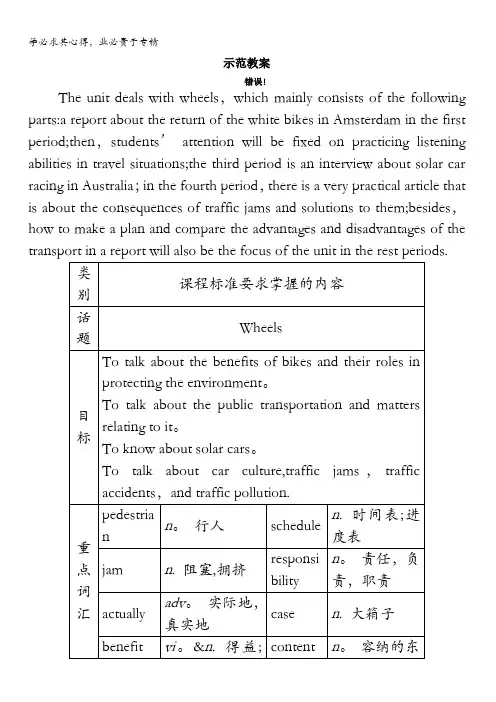
示范教案错误!The unit deals with wheels,which mainly consists of the following parts:a report about the return of the white bikes in Amsterdam in the first period;then,students’attention will be fixed on practicing listening abilities in travel situations;the third period is an interview about solar car racing in Australia;in the fourth period,there is a very practical article that is about the consequences of traffic jams and solutions to them;besides,how to make a plan and compare the advantages and disadvantages of the transport in a report will also be the focus of the unit in the rest periods.续表Period 1 Warm.up and Lesson 1 On Your Bike错误!Analysis of the teaching materialsThe first lesson of Unit 9 is a reading text。
In this lesson,the developing process of bikes is mainly dealt with and meanwhile,the advantages of bicycles are highlighted。
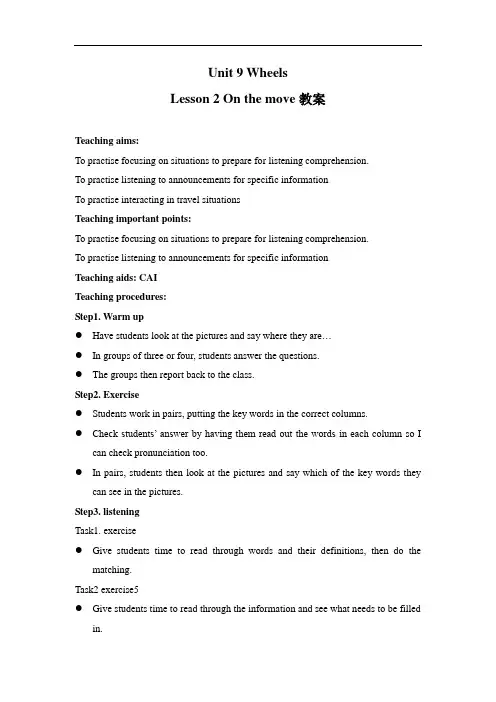
Unit 9 WheelsLesson 2 On the move教案Teaching aims:To practise focusing on situations to prepare for listening comprehension.To practise listening to announcements for specific informationTo practise interacting in travel situationsTeaching important points:To practise focusing on situations to prepare for listening comprehension.To practise listening to announcements for specific informationTeaching aids: CAITeaching procedures:Step1. Warm up●Have students look at the pictures and say where they are…●In groups of three or four, students answer the questions.●The groups then report back to the class.Step2. Exercise●Students work in pairs, putting the key words in the correct columns.●Check students’ answer by having them read out the words in ea ch column so Ican check pronunciation too.●In pairs, students then look at the pictures and say which of the key words theycan see in the pictures.Step3. listeningTask1. exercise●Give students time to read through words and their definitions, then do thematching.Task2 exercise5●Give students time to read through the information and see what needs to be filledin.●Students listen to the cassette once and see how much information they can get. Task3. exercise6●Read the listening Strategies with the students. Ask them to think of othersituations and the sort of language they would expect to hear. eg. at a bus station, in a restaurant, in a classroom, in a hospital●Students then listen to the dialogue and decide where they are taking place andwhat the people are talking about.Task4. exercise 7●Give students time to read though the dialogues and guess the missing words.●Then play the cassette again for students to complete the dialogues and checktheir guesses.。
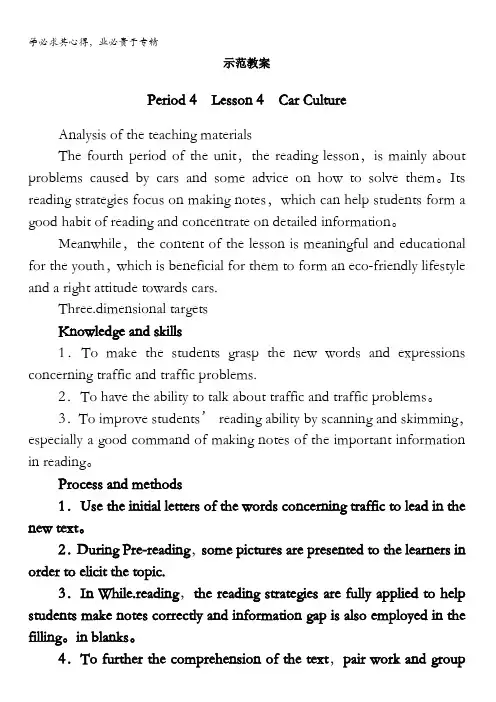
示范教案Period 4 Lesson 4 Car CultureAnalysis of the teaching materialsThe fourth period of the unit,the reading lesson,is mainly about problems caused by cars and some advice on how to solve them。
Its reading strategies focus on making notes,which can help students form a good habit of reading and concentrate on detailed information。
Meanwhile,the content of the lesson is meaningful and educational for the youth,which is beneficial for them to form an ecofriendly lifestyle and a right attitude towards cars.Three.dimensional targetsKnowledge and skills1.To make the students grasp the new words and expressions concerning traffic and traffic problems.2.To have the ability to talk about traffic and traffic problems。
3.To improve students’ reading ability by scanning and skimming,especially a good command of making notes of the important information in reading。
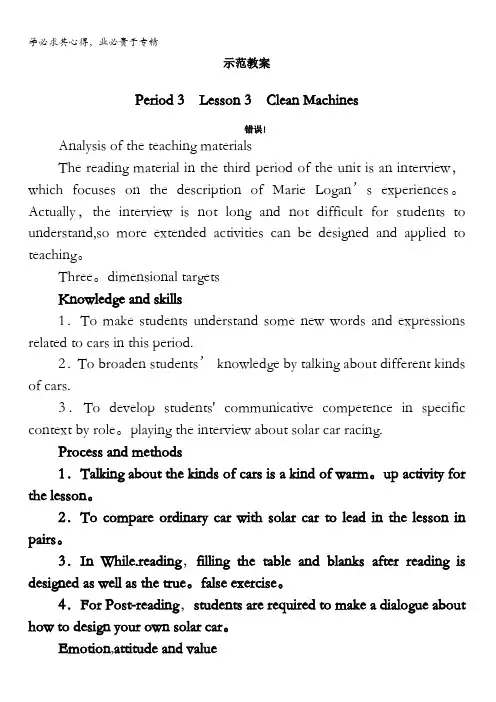
示范教案Period 3 Lesson 3 Clean Machines错误!Analysis of the teaching materialsThe reading material in the third period of the unit is an interview,which focuses on the description of Marie Logan’s experiences。
Actually,the interview is not long and not difficult for students to understand,so more extended activities can be designed and applied to teaching。
Three。
dimensional targetsKnowledge and skills1.To make students understand some new words and expressions related to cars in this period.2.To broaden students’ knowledge by talking about different kinds of cars.3.To develop students' communicative competence in specific context by role。
playing the interview about solar car racing.Process and methods1.Talking about the kinds of cars is a kind of warm。
up activity for the lesson。
2.To compare ordinary car with solar car to lead in the lesson in pairs。
名师精品教案Unit 9 WheelsLesson 1 On Your Bike一、教学目标1.Understand the main idea of the newspaper article.2.Get the detailed information about the development of the “white bikes”.3.T alk about “white bikes”.4.Get an idea of the benefits of bicycles and raise awareness of protecting the environment.二、重点难点Students may have difficulty talking with each other and sharing their ideas of the benefits of bicycles freely.学时重点Help students to get the detailed information about the development of the “white bikes”;talk about “white bikes”;get an idea of the benefits of bicycles and raise awareness of protecting the environment.学时难点Students may have difficulty talking with each other and sharing their ideas of the benefits of bicycles freely.三、教学过程Step1.Free talking: Do you use a bicycle? What do you usually do riding a bicycle?Step2. Ss discuss the advantages of bicycles over cars in groups.Step3.T introduces Amsterda m, “the City of Bicycles” and the Netherlands.Pre-reading:Step4.Ss read the title, look at the photo and guess what the text is about.While-readingStep5.Ss read the text quickly to check their guesses and find out the main idea of each paragraph. White bikes in the 1960s _________White bikes back in town _________Introduction of “the City of Bicycles” _________The effects of the “white bikes” _________Step6. Ss read the text carefully and find out the answers to the questions:Why is Amsterdam called the “City of Bicycles”?Why did the first “white bikes” plan fail?What effects have the “white bikes” had?Step7.Ss make a comparison and complete the table:Post-reading:Step8. DiscussionDo you think it is a good idea to have public bikes in our city? Why? Homework:Prepare a short report about the advantages and disadvantages of bicycles and cars; Preview the Grammar part.。
示范教案Period 6Grammar—PresentPerfect Continuous & Present Perfect整体设计Analysis of the teaching materialsThe main content of the period is the Present Perfect Continuous.Try to discover and conclude the usage of the grammar by analyzing and practicing;it is all right for students to understand that the Present Perfect Continuous is mainly used to focus on the activity itself,especially to explain visible consequences of it while the Present Perfect focuses on a result of an activity.Meanwhile,students have learned the two tenses in the junior middle school,so it is strongly recommended that the teaching focus should be on the practice.Three-dimensional targetsKnowledge and skills1.To experience the usage of the Present Perfect Continuous in contexts.2.To let students know how to identify the differences between the Present Perfect Continuous and the Present Perfect.Process and methods1.To lead in the lesson by a dialogue between the teacher and students.2.To ask students to observe some sentences related to the Present Perfect Continuous.3.To present the use of the Present Perfect Continuous and then let students practice it.4.To compare the differences between the Present Perfect and the Present Perfect Continuous.5.To sum up what they have learned in the period.Emotion,attitude and value1.To get students to become interested in grammar learning.2.To develop students' abilities of comparing and summarizing.Teaching & Learning methodsObservation—Discovery—Induction is effective for grammar learners.Teaching important & difficult pointsTo compare and practise using the Present Perfect Continuous and the Present Perfect.Teaching proceduresStep 1Lead-inThe teacher begins the class with the following questions:When did you start learning English?Are you learning now?How long have you been learning English?S:I have been learning English for/since...T:What tense does she/he use in the sentence?Today we are going to talk about the Present Perfect Continuous.Step 2Observation1.Students read four dialogues and match the dialogues with the pictures in Ex.4 on page 36.Students find out the key sentences that help them identify the pictures.Possible answers:1C;2D;3A;4B2.Use the dialogue in Ex.4 on page 36 to complete the table in Ex.5 on page 37.Possible answers:1.been 2.haven't 3.been 4.doing 5.Have 6.been3.Ask students to conclude the form of the Present Perfect Continuous from the sentences in Ex.4 and Ex.5.It is formed in this way:Subject+have/has+been+v.-ingStep 3PresentationWhen do we use the Present Perfect Continuous?1.We use the Present Perfect Continuous to talk about actions or situations that started in the past and are still in progress.Eg.He has been learning English for five years.(He is still learning English)2.When we talk about actions or situations that have recently stopped but they still have present results.Eg.—You are wet.—Yes,it has been raining a lot.3.When we talk about repeated or continuous actions.I have been sending him a lot of messages all day.In brief,the present perfect continuous is something that started in the past but is still happening,which focuses on the continuous action.The emphasis is on the duration of the action.Step 4Practice1.Finish Ex.6 on page 37 in pairs and then check the answers.Possible answers:b,c2.Finish Ex.7 on page 37 in pairs and then check the answers.Answers:a)have been cycling b)Has;been selling c)hasn't been driving d)have been playing3.Finish Ex.8 on page 37.4.Finish Ex.9 on page 37.Possible answers:1.She has been swimming. 2.He has been exercising. 3.He has been eating chocolates. 4.He has been painting.Step 5ExtensionNow we have been talking about the Present Perfect Continuous.There is a similar tense—the Present Perfect.Do you know the usage of the Present Perfect?1.We use the Present Perfect to talk about something that happened in the past and has the connection with the present.Eg.He has turned off the light.2.When we talk about actions or situations in the past without a definite time.Eg.He has lost his key.3.When we give information about a recent event.Spanish scientists have made important discoveries about cancer.4.When we talk about things we have done until now.Eg.I have painted ten pictures so far.5.When we talk about experiences we have had in life.Eg.Have you been to China?No,I haven't but I'd love to.Both the tenses almost use the same time adverbial.They are:ever,never,just,already,yet,for,since,recently,lately and so on.However,they do have differences;What are the differences bet w een them?They have been reading a book about the battle.(We are interested in the activity.The action has not finished.)They have read a book about the battle.(We pay attention to the result of the activity.The action has finished.)Step 6Practice1.Finish Ex.5 on page 41Possible answers:1.designing 2.taking part 3.building 4.writing 5.designed 6.taken part7.done8.written2. Finish Ex.6 on page 41Possible answers:a)for the present perfect continuous and b) for the present perfect.3.Finish Ex.7 on page 41Possible answers:1a;2b;3a4.Finish Ex.8 on page 41Possible answers:1.have;been 2.have been waiting 3.have been talking 4.haven't seen 5.has;been doing 6.has been working7.hasn't been getting on8.Has;had9.hasn't been looking10.has startedStep 7ConclusionTo sum up,the Present Perfect Continuous stresses duration and unfinished action and activity itself while the Present Perfect stressed achievement and finished action.Step 8Homework1.To find the sentences related to the present perfect continuous in the text “Return of the white bikes!” and “Solar Car Racing”.2.To finish Ex.10 on page 41.教学参考与现在完成进行时相关的高考真题1.(2011北京)Tom ______ in the library every night over the last three months.A.works B.workedC.has been working D.had been working解析:考查时态。
Unit 9 Wheels Lesson 2 On the move教案Teaching aims: To practise focusing on situations to prepare for listening comprehension. To practise listening to announcements for specific information To practise interacting in travel situations Teaching important points: To practise focusing on situations to prepare for listening comprehension. To practise listening to announcements for specific information Teaching aids: CAI Teaching procedures: Step1. Warm up Have students look at the pictures and say where they are… In groups of three or four, students answerthe questions. The groups then report back to the class. Step2. Exercise Students work in pairs, putting the key words in thecorrect columns. Check students’ answer by having them read outthe words in each column so I can check pronunciation too. In pairs, students then look at the pictures and say which of the key words they can see in the pictures. Step3. listening Task1. exercise Give students time to read through words and their definitions, then do the matching. Task2 exercise5 Give students time to read through the information and see what needs to be filled in. Students listen to the cassette once and see how much information they can get. Task3. exercise6 Read the listening Strategies with the students. Ask themto think of other situations and the sort of language they would expect to hear. eg. at a bus station, in a restaurant, in a classroom, in a hospital Students then listen to the dialogue and decide where they are taking place and what the people are talking about. Task4. exercise 7 Give students time to read though the dialogues and guess the missing words. Then play the cassette again for students to complete the dialogues and check their guesses.。
示范教案Period 5 Communication Workshop and Culture Corner Analysis of the teaching materialsThe period consists of two parts.The first part is communication workshop,which mainly deals with writing a report about traffic problems in Ludford.In this part function file is not practical and has little to do with writing a report;so it will be deleted.The second part is culture corner,which talks about the history of American cars,which is the extension of the wheels.Three.dimensional targetsKnowledge and skills1.To develop students' ability to write a report and know how to use addition and contrast linking words properly。
2.To let students know about the history of American cars by reading.3.To improve students' communicative ability。
Process and methods1.To make preparations for writing a report by a list of activities circling the traffic problems in Ludford。
示范教案Period 7 Summary of theLanguage Points of Each Period错误!Analysis of the teaching materialsThis is the last teaching period of the unit,so the emphasis should be placed on going over and summarizing what has been learned in the unit。
It mainly includes the following parts:the revision of the important expressions and sentences and more practice of the unit.Three。
dimensional targetsKnowledge and skills1.To get students to master the important new words,phrases and sentence patterns in the unit。
2.To develop students' ability to use the important language points.Process and methods1.To ask students to look through the whole unit to find the useful new words and expressions in the unit.2.To have a dictation about the useful words and expressions。
3.To help students review and master the usages of the important words and expressions and sentence patterns。
Unit 9 WheelsUnit objectivesDraw students' attention to the unit objectives and ask them which of these activities are new. For example, they may have read newspaper and magazine articles but not a report.Resource used: Cassette.Warm-upExercise 1Key Wordsaeroplane, balloon, bicycle, boat, bus, car, coach, ferry, helicopter, hovercraft, lorry, motorbike, ship, train, the underground, van, yacht■ Students work in pairs, reading the Key Words and completing the table. ■ When checking answers, students may wish to discuss both air and noise pollution and which types of transport cause the most pollution.AnswersLand: bicycle bus car coach lorry motorbike train van (NB: the underground travels under the land)Sea: boat ferry hovercraft ship yachtAir: aeroplane balloon helicopterCause pollution: aeroplane boat bus car coach ferry helicopter hovercraft lorry motorbike ship the underground vanHave wheels: bicycle bus car coach lorry motorbike train the underground vanExercise 2■ Using the table in Exercise 1, students ask and answer questions about travel.■ Some of the pairs then report back to the class about their partner. ■ Find out which means of transport none of the students has been on and which means of transport the majority would like to go on.Exercise 3Key Wordscommuter, cyclist, lorry driver, motorist, pedestrian■ Students match the Key Words with the definitions.■ Check answers by having students say the definitions in full sentences, e.g. 'A commuter is someone who … .'Answerscommuter/3 cyclist/1 lorry driver/5 motorist/2 pedestrian/4■ Ask students to look back at the Key Words in Exercise 1 and give the names of the person who flies an aeroplane (pilot), rides a motorcycle (motorcyclist), drives a train (train driver), sails a ship/yacht (captain, sailor).Exercise 4■ Play the cassette twice for students to identify the five speakers from the definitions in Exercise 3.Answers1 lorry driver2 pedestrian3 cyclist4 motorist5 commuter■ When students have checked the answers, you may wish to play the cassette again for more intensive comprehension work, e.g. play the first speaker again and ask: ‘What time does he start work?’ (6 o’clock) ‘How far does he drive?’ (100 miles)Tapescript1 Well, I usually start work at about six in the morning. I don’t usually do long distances ?C the furthest I drive is about a hundred miles. It’s very stressful, know what I mean? Driving all day. And the traffic’s really bad nowadays, much worse than when I started. Traffic jams everywhere …2 Look at them! Cars parked everywhere. And crossing the road is really dangerous. People drive so fast. I was going across the road the other day with my grandson, and suddenly this big lorry came along and nearly hit us. And the pollution, it’s really terrible these days …3 People say I’m mad, ’cos I always ride to school. I love it and actually it’s much quicker than the bus or even a car because the traffic’s so bad these days. And it keeps me fit, doesn’t it?4 I know I use it too much, but public transport is terrible where I live. We live out of town, you know, and I need the car to go shopping, to go to work, to take the kids to school.Lesson 1 On Your BikeReadingGrammarLanguage in UseLesson 4 Car CultureObjectives■ To practise making notes of the important information from a reading text.■ To practise using collocations.■ To talk about traffic and traffic problems.Possible problemIf students are not used to making notes from texts in Chinese, they may have difficulties practising taking notes in English and using suitable abbreviations.BackgroundThe opening of London's major ring road, the M25, was supposed to ease the capital's traffic problems, but in fact the volume of cars moving in and around London is greater than ever. One encouraging piece of legislation is that lead-free petrol is now compulsory for new cars.Routes through the material. If you are short of time, set Exercise 2 for homework and omit Exercise 7.. If you have time, do the Options activities.. If you have two lessons for this unit, a suitable natural break is after Exercise 3.Language Power: pages 84-85.ReadingBefore you startExercise 1■ Read through the questions with the class.■ Give students time to think about the answers, then have individuals tell the class about their family and cars.Exercise 2Key Wordsaccident, air pollution, carbon monoxide, motorway, roadworks, speed limit, traffic jam, zebra crossing■ Before students look the words up in the dictionary, encourage them to guess the meaning by seeing if the word is similar to a word in their language, or by breaking the word down into parts (e.g. road works).■ Explain some of the following things that can be seen in the photos: the number plate on the car (number plates go with the car, they don't change with the owner); tax disk (which is displayed on the car's front window andshows that a yearly tax has been paid); double yellow lines (no parking allowed).Read to learnExercise 3■ Read the Strategies with the class.■ Look at the headings in the notes and discuss what information is needed to complete the notes.■ Write these words on the board and ask students how they can be abbreviated, e.g. by omitting letters, by taking the first letters, by omitting the vowels: ‘increase’ (inc), ‘years’ (yr), ‘minutes’ (mins), ‘million’ (m). ■ Students then work individually, reading the article and completing the notes.■ Students then compare notes in pairs before checking answers as a class. ■ When checking students’ answers, have individuals write their notes on the board so you can check abbreviations too.Suggested answersNumber of cars: 25millionIncrease in last ten years: 30%Amount of TV advertising: 1/4Proportion of short car journeys: 25% under 2 milesChemicals produced by cars: carbon monoxide, ozoneHealth effects of air pollution: 25,000 deaths p.a., 1 in 7 children suffers from asthma, types of cancer caused by traffic pollutionNo. of road deaths: over 3,000 per yearAdvs. of buses over cars: 40 people travel in 1 bus (but the same no. would need 33 cars), you can relax on a bus Advs. of sharing a car: cheaper and kinder to environmentAdvs. of physical ex.: saves money, keeps you fit and helps you live longer, cuts the risk of heart diseaseWays of making streets safer: speed limit, zebra crossing,pedestrian areaExercise 4■ Students work in pairs, reading the text again and discussing the answers to the questions.Answers1 roads2 makes them angry and stressed/they become addicted to their cars3 because they want to continue using their cars4 They present an untrue picture of driving and cars.5 We should take action by writing to the papers, going to the town council, getting a protest group together.Exercise 5■ As a whole class, students discuss which of the three sentences best summarises the writer’s attitude to cars. Encourage students to argue for their own opinion.Answers2 (or possibly 1)Vocabulary: CollocationsExercise 6■ Do the first two items with the whole class, then have students work in pairs, matching the words.Answers1 e2 i3 g4 f5 j6 c7 d8 b9 h 10 aSpeakingExercise 7■ Students work in pairs, asking and answering the questions.■ Discuss the answers to question 3 as a whole class and elicit students' suggestions for coping with the frustration of traffic jams.■ In groups of four or five, students discuss the answers to the questions. ■ The groups then report back to the whole class and see how similar their answers are.OptionsPracticeStudents look back at the Key Words in Exercise 2 and take turns to make sentences containing a Key Word, e.g. 'He had an accident on the M25.' Write the following words on the board: lights, window, bonnet, wheel, number platesStudents then use these words to label the photo on page 42.ExtensionStudents look back at Exercise 6 and make sentences using the collocations, e.g. 'He goes to the gym to keep fit.'Additional exercise for vocabularyUseful vocabulary:destruction, addiction, be addicted to, be/ get stuck in, stressed out,compare to, cost, carry on, confess, risk, occupy, complain about■ Use the words or phrases from the text to complete the sentences.1. The floods brought death and ________ to the area.2. The boat ________ the mud.3. Workers who had lost their jobs ________ the way they had been treated.4. Occasionally people ________ to crimes they haven't committed just to get attention.5. I tried to give up smoking several times before I realized I ________ it.6. Three companies ________ the new building.7. ________ our small flat, Bill's house seemed like a palace.8. Studying for exams always ________.9. This doesn't include the ________ of repairing the damage.Answers1 destruction2 was stuck in3 complained about4 confess5 had addicted to6 occupies7 Compared to8 stresses me out9 costCommunication WorkshopObjectives■ To practise making notes of the important information from a reading text. ■ To practise using collocations.■ To prepare for a speaking activity and to participate in discussion. ■ To discuss suggestions.■ To write a report.■ To use addition and contrast linking words.■ To listen to and understand a song.Resources used: Cassette, Writing Help 3.BackgroundJohn Denver (1943-1997) was a popular country and folk singer. He wrote and sang many worldwide hits (including Leaving on a Jet Plane) and his albums sold millions. He also did a lot of charity work for underprivileged children and campaigned for ecological causes. He died in a plane crash.Routes through the material. If you are short of time, set some of the written exercises for homework. . If you have time, do the Option Activity.. If you have two lessons for this unit, a suitable natural break is after the Speaking activity.Language Power: pages 86-87.Speaking: A DiscussionBefore you startExercise 1■ Advise students to read through the text quickly to get a general idea of the content before filling in as many gaps as they can.■ Students compare their answers in pairs before listening to the cassette to check their answers.Answers1 main2 through3 accidents4 lorry5 pollution6 dirty7 damaged8 traffic jam9 park 10 shoppersTapescriptPresenter: And here is this week's County Report. At a council meeting yesterday, Ludford's traffic problems were discussed. The main problem is the A49 road, which goes right through the town.There have been several serious accidents recently―last week two children were killed by a lorry near the school. A report last year also showed that air pollution from traffic is increasing and the old buildings in the town are getting dirty and damaged.There is a terrible traffic jam every morning at Ludford Bridge and there’s nowhere to park in the centre. Because of the traffic, shoppers are going to other towns and local shops are closing down.Exercise 2■ Students work in pairs, studying the map and matching the words to the numbers on the map.Answersa) 3/4 b) 7/8 c) 5/6 d) 1/2Exercise 3■ Give students time to read through the expressions and the Function File and guess where the expressions fit into the sentences.■ Students listen to the cassette and complete the Function File, checking their guesses.Answers1 should2 sure3 would4 Why don’t5 good idea6 how about7 don’t think8 What aboutTapescriptGirl: So, what do you think about all these new plans for the town? Personally, I think they should build the bypass. It would get the traffic out of the town.Boy: I’m not so sure. It would be very expensive and it would take a long time. It’s also not very ecological. Think about the wildlife. Why don’t they improve the bus service? It’s not very good at the moment. More people would use the buses if they were cheap and came regularly, and there would be less traffic.Girl: That’s a good idea. The buses are terrible at the moment. You have to wait ages.Boy: Mm, I know.Girl: And how about building a shopping centre? The nearest one’s miles away. Boy: I don’t think that’s a very good idea. What about the local shops? What would happen to them? And anyway I hate those big shopping centres …Stages 1-4■ Students follow the four stages to decide on the best plan for Ludford. ■ In pairs, students read the Strategies.■ Students then work in pairs listing the advantages and disadvantages of the four plans (a?Cd) in Exercise 2.■ The pairs then decide on their plan. Tell students that their plan can include their own ideas as well as the ones given in Exercise 2.■ In groups of four, the pairs tell each other about their plans and try to agree on a solution. Remind students to use the expressions from the Function File.Talkback■ The groups report back to the class. Encourage students to use the board to illustrate their plans for the town if they wish.■ The class then discusses which of the solutions are the most ecological. ■ Ask students if they had any language difficulties when they were working out their solutions. Was there anything they wanted to say but didn’t know how to say?Writing: A ReportBefore you startExercise 1■ Ask students if they have seen or written any reports, e.g. school reports, club/society reports, town council reports, government reports.■ Elicit how reports are usually structured, e.g. stating the topic of thereport, giving positive points, giving negative points and offering advice, then concluding.■ Tell students they have to order the main sections (A-E), not thesub-sections within the main sections.■ Students work individually, reading the extracts and ordering them.■ They can compare their answers in pairs before checking answers in Writing Help 3.AnswersB D A E CLinkingExercise 2■ Students find the linking words in the report and then, working in pairs, write the words in two groups: 1 listing ideas, 2 contrasting ideas. AnswersListing ideas: and in addition plus also as well as tooContrasting ideas: but although however on the one hand on the other handStages 1-3■ Students follow the three stages to write a report for a school magazine. ■ As a whole class, elicit ideas for the advantages and disadvantages of the present local transport system.■ Students then work in pairs, listing the advantages and disadvantages. ■ Refer students to Writing Help 3 as they write their reports.■ Students refer to Writing Help 3 as they check their reports.■ If you wish, have students work in pairs, checking their reports and helping each other correct any mistakes.Listening: A Song■ Give students time to read through the questions before they listen to the song.■ Play the song twice for students to check their answers.Answers1 He’s standing outside her door.2 It’s early morning.3 He feels lonesome/lonely/sad.4 He doesn’t know when he’ll come back.5 He wants to marry her.TapescriptAll my bags are packed, I’m ready to go,I’m standing here outside your door,I hate to wake you up to say goodbye.But the dawn is breaking, it’s early morn,The taxi’s waiting, he’s blowing his horn,Already I’m so lonesome I could cry.So kiss me and smile for me, tell me that you’ll wait for me, Hold me like you’ll never let me go.I’m leaving on a jet plane, don’t know when I’ll be back again. Oh, babe, I hate to go.There’s so many times I’ve let you down,So many times, I’ve played around,I’ll tell you now they don’t mean a thing.Every place I go, I’ll think of you,Every song I sing, I’ll sing for you;When I come back, I’ll wear your wedding ring.So kiss me and smile for me, tell me that you’ll wait for me, Hold me like you’ll never let me go.I’m leaving on a jet plane, don’t know when I’ll be back again. Oh, babe, I hate to go.Now the time has come to leave you, one more time let me kiss you, Then close your eyes, I’ll be on my way.Dream about the days to come when I won’t have to leave alone, About the time I won’t have to say:Leaving on a jet plane, don’t know when I’ll be back again. Leaving on a jet plane, don’t know when I’ll be back again.OptionExtensionWrite this gapped text of the first part of the song on the board: All my (1) … are packed, I’m ready to (2) … ,I’m (3) … here outside your (4) … ,I (5) … to wake you up to say (6) … ,But the dawn is breaking, it’s (7) … morn,The (8) … waiting, he’s blowing his (9) … ,Already I’m so lonesome I could (10) … .Students work in pairs, filling in the gaps.Check students’ answers by playing the song again.Culture CornerCulture CornerAmerica on the WheelBefore reading■ Elicit information about cars and car history from students’ background knowledge to arouse their interest in reading, such as what they know about cars, how many brands of cars they know, the history of car making, what kind of car they like and why……■ Get students to skim the title and the pictures and predict what the passage is about. Get them to practice the reading strategy―-predicting. Exercise 1Key Wordsmotor car, invent, mass production, practical, radically, reign■ Look at the Key Words with the students and see if students already know some of them. Do not pre-teach any new words but encourage students to guess their meanings as they read the text. Remind them of referring to the notes while reading.■ Students read the text and check their prediction.■ Students scan the text to find the Key Words, guess them in the context and do the matching.Answers1 region2 invent3 practical4 motor car5 radically6 mass production ■ Students check the answers in pairs first before checking in class.Exercise 2■ Students read the text again and then in pairs ask and answer the questions. Encourage them to ask more questions according to the text if possible or if you have time.Answers1 It was Henry Ford who built the world’s first mass production car.2 Model T Ford was simple, practical and cheap.3 Those European cars were stylish and cheaper.Bulletin BoardObjectives■ To develop students interests in car culture.■ To display students ability of imagination.■ To exchange creative ideas about car development.■ To further explore the theme of the unit■ Ask students to read the note on the Bulletin Board.■ Students work individually to design a creative car. Then they work in groups to exchange ideas. They may change some of their ideas and then makea drawing of their own car■ Students read the two descriptions. Use them as a model of their own writing. ■ Students write a description of their own creative car invention.■ Display the descriptions on the class bulletin board. Encourage students to read other students’ descriptions after class.Unit DiaryObjectives■ To reflect what and how much the students have learned.■ To think about in what way they are learning.■ To learn and identify the best ways for learning.■ To develop students’ confidence in taking more control of their studies. ■ To help teachers get a clearer insight into the students’ learning of the language.Part 1 (1)This part gets students to think of the topics of the unit and decide whichis their favourite lesson.Part 2 (2-6)This part refers back to the unit objectives from the start of the unit, evaluating the difficulty and usefulness of the activities for each of the tasks.Part 3 (7)This part gets students to reflect on the learning strategies, to identify and discuss better ways that suits his or her own language learning.Part 4 (8)This part focuses on the students’ interests in different topics.Part 5 (9)This part is self-evaluation, which helps students make proper justification of their study and lay down plans for further progress.Module 3 ProjectThe Future of TransportationObjectives■ To interact and cooperate with others in a team.■ To develop skills in collective decision-making.■ To practise skills in researching and collecting information.■ To judge whether information is appropriate.■ To learn how to prioritize information and present it in an appropriate manner.■ To describe a prediction about the transportation in the future using appropriate language.■ To develop the ability of organizing useful materials.■ To assess one's own work and reflect on ways on how to improve it.Resources usedthe Internet; books, magazines, newspapers, TV, pictures and photos, …about transportation; Bilingual dictionaryPossible problemsSome of the required resources may not be readily available to students. There may not be enough interesting materials of transportation for students to use. The list of the suggested areas may be too broad and students may have limited imagination and knowledge about the future of transportation.Process1 Divide the class into small groups. Ask each group to choose a topic from the list. They can also discuss other topics they are interested in.a) public transportationb) personal transportationc) pollution solutiond) the role of traditional transportatione) an end to traffic jamf) worldwide travelg) space travelh) other____________2 Ask groups to brainstorm the present situation about transportation and make notes. Tell them to research all possible predictions and imaginations about future transportation.3 Ask each group to write a description of future transportation and find photos and other materials to support their presentation.Stage 1Students use materials and the Internet to research relevant information about their topic. They make notes about the events.Stage 2Each group gathers their research notes and discusses the information. Then they decide on the materials to support their opinion. Make sure each group finds different materials.Stage 3Each group makes sure that every member has a role to play. For example, some can write the present situation of transportation, some can write about the future, some make the design, while others choose photos or draw pictures of the project.Stage 4Give each group a chance to present their report to the class. Encourage students to ask the group questions about their project.Stage 5Ask each group to do a self-assessment with the following questions.1 Are you satisfied with your preparation for the project?Yes NoWhy?2 Are you satisfied with the method of presentation that your group choose? Yes NoWhy?3 How will you improve your project work in the future?____________________________________________________________________________________________________4 What did you learn from other groups?____________________________________________________________________________________________________Stage 6Ask a student from each group to read out their answers to the assessment questions. Comment and encourage students to think about their answers as preparation for their next project.Review。